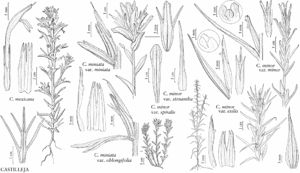Castilleja minor var. stenantha
Phytologia 90: 73. 2008.
Herbs 2.8–10(–15) dm. Stems: hairs sparse to dense, short to long, soft, sparsely stipitate-glandular. Leaves linear-lanceolate to lanceolate, soft, margins plane. Bracts distally red to pale orange, linear to narrowly lanceolate, apex acuminate. Calyces 14–22(–28) mm; abaxial and adaxial clefts 7–15 mm, 50–60% of calyx length, lateral 1–1.5(–3) mm, 10–20% of calyx length; lobes linear to narrowly triangular, apex acute to acuminate. Corollas 23–39 mm; beak exserted, adaxially light reddish brown, yellowish, pale orange, or reddish orange, 8–15(–20) mm; abaxial lip whitish, rarely greenish or pale yellow (sometimes red in in c Arizona).
Phenology: Flowering Feb–Sep.
Habitat: Riparian zones, chaparral, wet cliffs, often over serpentine.
Elevation: 0–2500 m.
Distribution
Ariz., Calif., Mexico (Baja California).
Discussion
Variety stenantha is most common in central and southern California west of the Sierra Nevada crest, southward to at least the Sierra San Pedro Mártir in Baja California. It is associated with serpentine, granite, and other substrates.
Selected References
None.
